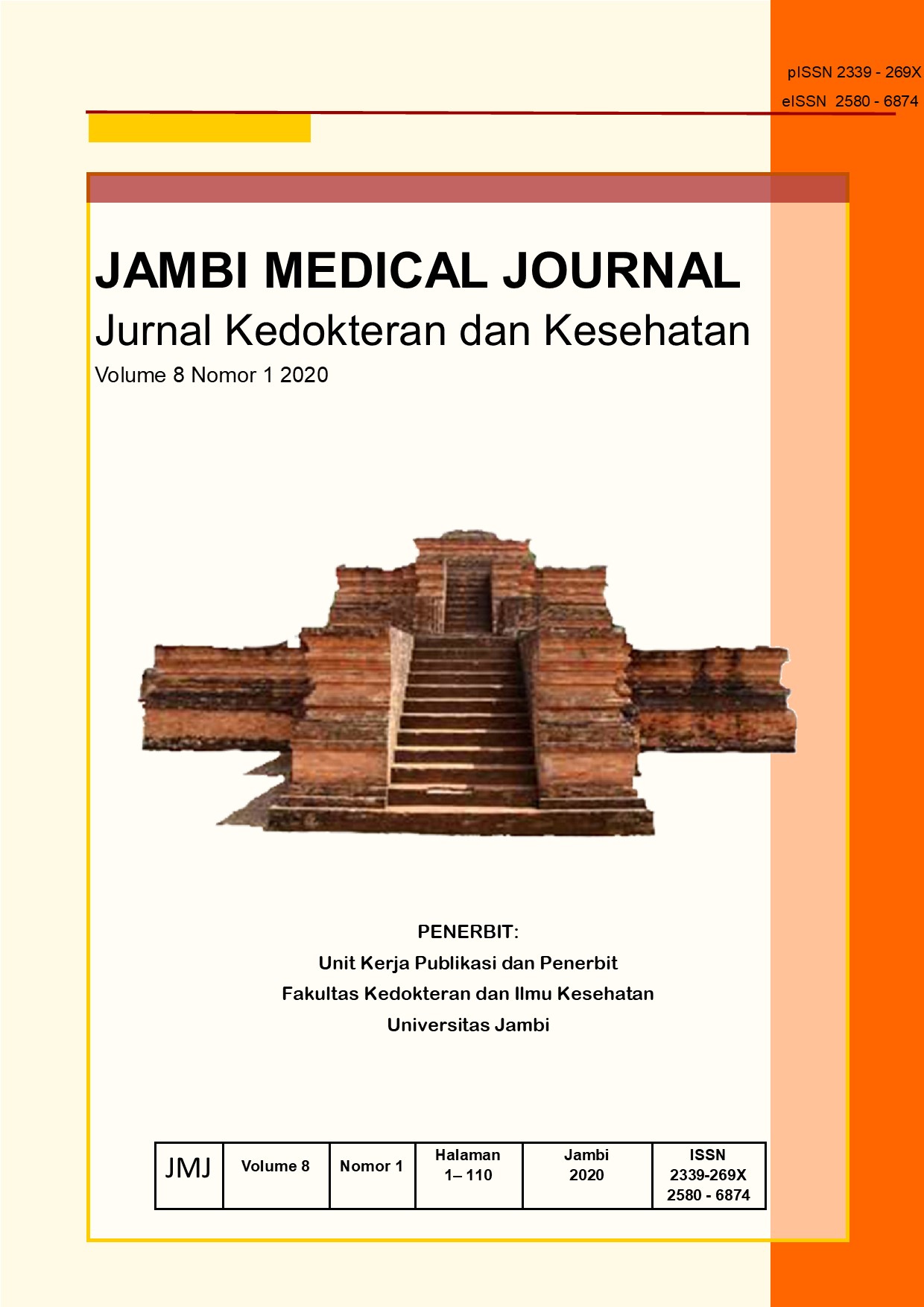KORELASI MASA LEMAK DAN LEMAK VISERAL DENGAN KADAR LEPTIN SERUM PADA REMAJA OVERWEIGHT DAN OBESITAS
DOI:
https://doi.org/10.22437/jmj.v8i1.9477Abstract
ABSTRACT
Background:The prevalence of adolescent obesity (15-18 years) in Indonesia continues to increase. The results of basic health research in 2013 showed the prevalence of adolescent obesity from 1.4% in 2010 increase to 7.3% in 2013. The condition of obesity will affect leptin secretion which plays a role in influencing food intake by controlling appetite in the hypothalamus and brain stem. Objective: This study aims to determine the description, differences, and correlations of the fat mass, visceral fat, and serum leptin levels in the group of adolescents who are overweight and obese. Design: This study was conducted by analytic survey method with cross sectional approachment. The sample consisted of 60 people aged above 18 years state as students of the Faculty of Medicine and Health Sciences Jambi University who were overweight and obese. Analyze data from the examination of fat mass, visceral fat, and serum leptin using the Pearson Correlation test and for the characteristics of FKIK Unja students aged above 18 years with BMI ≥23 will be analyze distributively. Results: The analysis showed significant results p = 0.000 and a high correlation of r = 0.719 between fat mass with leptin levels where the fat mass is directly proportional to leptin levels. The analysis showed that the results were not significant with p = 0.338 and did not correlate r = -0.126 between visceral fat and leptin levels. Conclusions: From this study obtained a body composition profile, leptin level profile and food intake data in overweight and obese adolescents, which will be used as initial screening to make lifestyle modifications and healthy behavior in overweight and obese adolescents so that in the future they will not be a risk factor for metabolic syndrome
KEY WORDS: Obesity; Overweight; Fat mass; Visceral fat; Leptin
ABSTRAK
Latar belakang: Prevalensi obesitas remaja di Indonesia terus meningkat. Hal ini dapat berdampak buruk terhadap kesehatan karena obesitas berkaitan dengan noncommunicable diseases (penyakit-penyakit tidak menular). Keadaan obesitas yang ditandai dengan meningkatnya massa lemak dan lemak viseral akan mempengaruhi sekresi leptin dan menyebabkan terjadi resistensi leptin, dimana kondisi hiperleptinemia pada obesitas menjadi faktor risiko independen terhadap penyakit kardiovaskuler.
Tujuan: Penelitian ini bertujuan untuk mengetahui korelasi masa lemak dan lemak viseral dengan kadar leptin pada remaja yang mengalami overweight dan obesitas
Metode: Penelitian ini dilakukan dengan metode survey analitik dengan pendekatan cross sectional. Sampel berjumlah 60 orang remaja overweight dan obesitas dengan usia 17- 25 Analisa data hasil pemeriksaan massa lemak, lemak viseral, dan leptin serum menggunakan uji Korelasi Pearson dan untuk karakteristik mahasiswa FKIK Unja usia >18 tahun dengan IMT ≥23 akan dianalisis distributifnya. Hasil: Analisis menunjukkan hasil yang signifikan p = 0.000 serta korelasi r = 0,719 yang tinggi antara massa lemak dengan kadar leptin dimana massa lemak berbanding lurus dengan kadar leptin. Analisis menunjukkan hasil yang tidak signifikan dengan p = 0.338 serta tidak berkorelasi r = -0,126 antara lemak viseral dengan kadar leptin. kesimpulan: Dari penelitian ini didapatkan profil komposisi tubuh, profil kadar leptin dan data asupan makanan pada remaja yang overweight dan obesitas, yang akan dijadikan skrining awal untuk melakukan modifikasi gaya hidup dan perilaku hidup sehat pada remaja overweight dan obesitas sehingga kedepan tidak menjadi faktor risiko terkena sindroma metabolik.
KATA KUNCI: Obesitas; Overweight; Masa lemak; Lemak viseral; Leptin












